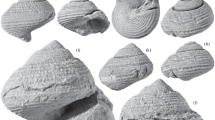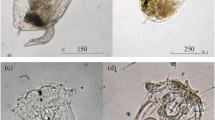Abstract
A comprehensive re-description of the monogonont rotifer Synchaeta oblonga Ehrenberg, 1832 is presented with the aim of creating a specific and robust suite of characters to identify this species that takes account of its morphological intraspecific variability. To accomplish this, we used an integrative approach that combined morphological data of the habitus and trophi (light and scanning electron microscopy) together with ecological and molecular data to generate a data set that clearly delineates S. oblonga from the morphologically similar Synchaeta tremula (Müller, 1786) with which it is often confused. In addition, by comparing S. oblonga to all remaining members of the genus Synchaeta, we found that the literature descriptions of Synchaeta rufina Kutikova and Vasiljeva, 1982, a Lake Baikal endemic species, and Synchaeta littoralis Rousselet, 1902, a species whose taxonomic status with respect to S. oblonga had already been called into question, to both lie entirely within the range of intraspecific morphological variability present in S. oblonga. Thus, we conclude that S. oblonga can be clearly demarcated from S. tremula, but that no unambiguous morphological differences exist to delineate it from either S. rufina or S. littoralis. Because our molecular data indicate S. oblonga to be a single species despite the morphological intraspecific variability that is present, we recommend that thorough re-examinations of the taxonomic statuses of both S. rufina and S. littoralis should be performed on topotypes sampled from their type localities (Lake Baikal, Russia and Dundee, Scotland, respectively).







Similar content being viewed by others
References
Althaus, B. (1957). Faunistisch-ökologische Studien an Rotatorien salzhaltiger Gewässer Mitteldeutschlands. (Nachtrag). Wissenschaftliche Zeitschrift der Martin-Luther-Universität Halle-Wittenberg (Sonderdruck), 6, 1–157.
Amrén, H. (1964). Ecological and taxonomical studies on zooplankton from Spitsbergen. Zoologiska Bidrag från Uppsala, 36(2), 209–276.
Arndt, H., Schröder, C., & Schnese, W. (1990). Rotifers of the genus Synchaeta—an important component of the zooplankton in the coastal waters of the southern Baltic. Limnologica, 21, 233–235.
Bandelt, H. J., Forster, P., & Röhl, A. (1999). Median-joining networks for inferring intraspecific phylogenies. Molecular Biology and Evolution, 16(1), 37–48.
Birky, C. (1964). Studies on the physiology and genetics of the rotifer, Asplanchna. I. Methods and physiology. Journal of Experimental Zoology, 155(3), 273–291.
Brownell, C. L. (1988). A new pelagic marine rotifer from the southern Benguela, Synchaeta hutchingsi, n.sp., with notes on its temperature and salinity tolerance and methods of culture. Hydrobiologia, 162, 225–233.
Buchholz, H. A. (1952). Das Brackwasserzooplankton an der schleswig-holsteinischen Ostseeküste. Christian-Albrechts-Universität Kiel.
De Smet, W. H. (1998). Preparation of rotifer trophi for light and scanning electron microscopy. Hydrobiologia, 387, 117–121.
Dokulil, M. T., & Herzig, A. (2009). An analysis of long-term winter data on phytoplankton and zooplankton in Neusiedler See, a shallow temperate lake, Austria. Aquatic Ecology, 43(3), 715–725.
Donner, J. (1959). Bemerkungen zur Rädertierart Synchaeta oblonga EHRB. 1832. Verhandlungen der Zoologischen-Botanischen Gesellschaft Wien, 98(99), 26–30.
Duggan, I. C., Green, J. D., & Shiel, R. J. (2002). Distribution of rotifer assemblages in North Island, New Zealand, lakes: relationships to environmental and historical factors. Freshwater Biology, 47(2), 195–206.
Edgar, R. C. (2004). MUSCLE: multiple sequence alignment with high accuracy and high throughput. Nucleic Acids Research, 32(5), 1792–1797.
Ehrenberg, C. G. (1832). Über die Entwicklung und Lebensdauer der Infusionsthiere, nebst ferneren Beiträgen zu einer Vergleichung ihrer organischen Systeme. In Physikalische Abhandlungen der Königlichen Akademie der Wissenschaften zu Berlin (pp. 1–145). Berlin: Druckerei der Königlichen Akademie der Wissenschaften.
Ehrenberg, C. G. (1834). Dritter Beitrag zur Erkenntnis großer Organisation in der Richtung des kleinsten Raumes. In Physikalische Abhandlungen der Königlichen Akademie der Wissenschaften zu Berlin (pp. 145–336). Berlin: Druckerei der Königlichen Akademie der Wissenschaften.
Folmer, O., Black, M., Hoeh, W., Lutz, R., & Vrijenhoek, R. (1994). DNA primers for the am-plification of mitochondrial cytochrome c oxidase I from metazoan invertebrates. Molecular Marine Biology and Biotechnology, 3(5), 294–299.
Fontaneto, D., De Smet, W., & Ricci, C. (2006). Rotifers in saltwater environments, re-evaluation of an inconspicuous taxon. Journal of the Marine Biological Association of the United Kingdom, 86(4), 623–656.
Fontaneto, D., & De Smet, W. (2015). 4. Rotifera. In A. Schmidt-Rhaesa (Ed.), Handbook of zoology, Gastrotricha and Gnathifera (pp. 216–300). Berlin: De Gruyter.
Gosse, P. H. (1887). Twenty-four new species of Rotifera. Journal of Microscopy, 7(1), 1–7.
Gouy, M., Guindon, S., & Gascuel, O. (2010). SeaView version 4: a multiplatform graphical user interface for sequence alignment and phylogenetic tree building. Molecular Biology and Evolution, 27(2), 221–224.
Harring, H. K. (1921). The Rotatoria of the Canadian Arctic Expedition 1913–1918. Report of the Canadian Artic Expedition 1913–1918, Ottawa, 8, 1–23.
Hollowday, E. D. (1949). A preliminary report on the Plymouth marine and brackish-water Rotifera. Journal of the Marine Biological Association of the United Kingdom, 28(1), 239–253.
Hollowday, E. D. (2002). Family Synchaetidae Hudson & Gosse, 1886. In H. J. F. Dumont, T. Nogrady, & H. Segers (Eds.), Rotifera. Volume 6: the Asplanchnidae, Gastropodidae, Lindiidae, Microcodinidae, Synchaetidae, Trochosphaeridae and Filinia. Guides to the identification of the microinvertebrates of the continental waters of the world (pp. 87–159). Leiden: Backhuys Publishers.
Jersabek, C. D. & Leitner, M. F. (2013). Synchaeta littoralis Rousselet, 1902. The Rotifer World Catalog. World Wide Web electronic publication. http://rotifera.hausdernatur.at/Species/Index/1890. Accessed 10 February 2018.
Jersabek, C. D., De Smet, W. H., Fischer, C., Fontaneto, D., Michaloudi, E., Wallace, R. L., & Segers, H. (2015). List of available names in zoology, candidate part Phylum Rotifera, species-group names established before 1 January 2000. 1) Completely defined names (A-list), 217 pp. and 2) incompletely defined names, with no types known (B-list). http://iczn.org/sites/iczn.org/files/LAN_CandidatePart-SpeciesRotifera-2015-12-04.pdf. Accessed 29 May 2018.
Kimpel, D., Gockel, J., Gerlach, G., & Bininda-Emonds, O. R. P. (2015). Population structuring in the monogonont rotifer Synchaeta pectinata: high genetic divergence on a small geographical scale. Freshwater Biology, 60(7), 1364–1378.
Kleinow, W., Klusemann, J., & Wratil, H. (1990). A gentle method for the preparation of hard parts (trophi) of the mastax of rotifers and scanning electron microscopy of the trophi of Brachionus plicatilis (Rotifera). Zoomorphology, 109(6), 329–336.
Koste, W. (1978). Rotatoria. Die Rädertiere Mitteleuropas. Band I und II. Begründet von Max Voigt. Monogononta. Berlin: Borntraeger.
Kutikova, L., & Vasiljeva, G. (1982). Novye I endemichnye kolovratki rodov Synchaeta i Euchlanis v faune Bajkala. Novoje O Faune Bajkala, 43–58.
Lauterborn, R. (1894). Die pelagischen Protozoen und Rotatorien Helgolands. Wissenschaftliche Meeresuntersuchungen, 1, 207–213.
Leigh, J. W., & Bryant, D. (2015). POPART: full-feature software for haplotype network construction. Methods in Ecology and Evolution, 6(9), 1110–1116.
Melone, G., & Ricci, C. (1995). Rotatory apparatus in Bdelloids. Hydrobiologica, 313(1), 91–98.
Montero-Pau, J., Gómez, A., & Muñoz, J. (2008). Application of an inexpensive and high-throughput genomic DNA extraction method for the molecular ecology of zooplanktonic dia-pausing eggs. Limnology and Oceanography: Methods, 6(6), 218–222.
Müller, O. F. (1786). Animalcula Infusoria fluviatilia et marina, quae detexit, systematice descripsit et ad vivum delineari curavit sistit opus hoc posthumum quod cum tabulis aeneis L. in lucem tradit vidua ejus nobilissima, cura Othonis Fabricii. Hauniae, LVI, 1–367.
Obertegger, U., Braioni, M. G., Arrighetti, G., & Flaim, G. (2006). Trophi morphology and its usefulness for identification of formalin-preserved species of Synchaeta Ehrenberg, 1832 (Rotifera: Monogononta: Synchaetidae). Zoologischer Anzeiger, 245(2), 109–120.
Pejler, B. (1957). On variation and evolution in planktonic Rotatoria. Zoologiska Bidrag från Uppsala, 32, 1–66.
Pontin, R. M. (1978). A key to the freshwater planktonic and semi-planktonic Rotifera of the British Isles. Ambleside: Freshwater Biological Association.
Pourriot, R. (1965). Notes taxonomiques sur quelques Rotiféres planctoniques. Hydrobiologia, 26(3/4), 579–604.
Raupach, M. J., Mayer, C., Malyutina, M., & Wägele, J. W. (2009). Multiple origins of deep-sea Asellota (Crustacea: Isopoda) from shallow waters revealed by molecular data. Proceedings of the Royal Society of London, Series B: Biological Sciences, 276(1658), 799–808.
Raupach, M. J., Astrin, J. J., Hannig, K., Peters, M. K., Stoeckle, M. Y., & Wägele, J. W. (2010). Molecular species identification of Central European ground beetles (Coleoptera: Car-abidae) using nuclear rDNA expansion segments and DNA barcodes. Frontiers in Zoology, 7(1), 26.
Remane, A. (1929). Rotatoria. In G. Grimpe (Ed.), Die Tierwelt der Nord- und Ostsee (pp. 1–156). Leipzig: Akademische Verlagsgesellschaft.
Rousselet, C. (1902). The genus Synchaeta: a monographic study, with descriptions of five new species. Journal of Microscopy, 22(4), 393–411.
Rozanska, Z. (1963). Zooplankton Zalewu Wislanego. Zeszyty Naukowe Wysej Szkoly Rolniczej w Olsztynie, 16(278), 41–57.
Ruttner-Kolisko, A. (1972). Rotatoria. In H. J. Elster & W. Ohle (Eds.), Die Binnengewässer, Bd. 26. Das Zooplankton der Binnengewässer. 1. Teil (pp. 99–234). Stuttgart: Schweizerbart’sche Verlagsbuchhandlung.
Sheveleva, N. G., Pomazkova, G. I., & Melnik, N. G. (1995). Eco-taxonomical review of Rotatoria, Cladocera, Calanoida and Cyclopoida of Lake Baikal. Japanese Journal of Limnology, 56(1), 49–62.
Shiel, R. J., & Koste, W. (1993). Rotifera from Australian inland waters. IX. Gastropodidae, Synchaetidae, Asplanchnidae (Rotifera: Monogononta). Transactions of the Royal Society of South Australia, 117(3), 111–139.
Segers, H. (2004). Rotifera: Monogononta. In C. M. Yule & H. S. Yong (Eds.), Freshwater invertebrates of the Malaysian region (pp. 106–120). Kuala Lumpur: Academy of Sciences of Malaysia and Monash University.
Segers, H. (2007). Annotated checklist of the rotifers (phylum Rotifera), with notes on no-menclature, taxonomy and distribution. Zootaxa, 1564, 1–104.
Smirnov, N. S. (1933). Rotatorien, gesammelt während der Expeditionen auf den Dampfern ‘Sedow’1930 und ‘Lomonossow’1931. Transactions of the Arctic Institute Leningrad, 8, 79–91.
Smith, J. C. (1904). Synchaeta bicornis: a new rotifer from the brackish waters of Lake Pontchartrain, Louisiana. Transactions of the American Microscopical Society, 25, 121–126.
Stemberger, R. S., & Gilbert, J. J. (1985). Body size, food concentration, and population growth in planktonic rotifers. Ecology, 66(4), 1151–1159.
Telesh, I., & Heerkloss, H. (2002). Atlas of estuarine zooplankton of the southern and eastern Baltic Sea. Part 1: Rotifera. Hamburg: Verlag Dr. Kovac̆.
Voigt, M. (1956–1957). Rotatoria. Die Rädertiere Mitteleuropas. I Textband, II Tafelband. Berlin: Borntraeger.
Wærvågen, S. B., & Andersen, T. (2017). Seasonal quantitative dynamics and ecology of pelagic rotifers in an acidified boreal lake. Journal of Limnology, 77(1), 147–160.
Wierzejski, A. (1893). Rotatoria (wrotki) Galicyi. Rozprawy Akademii Umiejętności w Krakowie. Wydział Matematyczno-Przyrodniczy, 6, 160–265.
Wilke, T., Ahlrichs, W. H., & Bininda-Emonds, O. R. P. (2017). A comprehensive and integrative re-description of Synchaeta tremula (Müller, 1786) and the newly rediscovered Synchaeta tremuloida Pourriot, 1965 (Rotifera: Synchaetidae). Zootaxa, 4276(4), 503–518.
Wilke, T., Ahlrichs, W. H., & Bininda-Emonds, O. R. P. (2018). On the importance of robust species descriptions for Rotifera: re-descriptions of Synchaeta stylata and Synchaeta longipes and a comparison to Synchaeta jollyae. Zoologischer Anzeiger., 277, 42–54.
Zeng, L., Liu, B., Dai, Z., Zhou, Q., Kong, L., Zhang, Y., He, F., & Wu, Z. (2017). Analyzing the effects of four submerged macrophytes with two contrasting architectures on zooplankton: a mesocosm experiment. Journal of Limnology, 76(3), 581–590.
Zimmermann-Timm, H., Holst, H., & Kausch, H. (2007). Spatial dynamics of rotifers in a large lowland river, the Elbe, Germany: how important are retentive shoreline habitats for the plankton community? Hydrobiologia, 593(1), 49–58.
Acknowledgments
We acknowledge Elina Kling and Janna Kling for the translation of Kutikova and Vasiljeva’s (1982) initial description of S. rufina and Backhuys Publishers for their permission to reproduce the drawings of S. rufina and S. littoralis from Hollowday (2002, p. 120, Figs. 117 and 122; p. 158, Fig. 277). We further thank Andreas Wanninger for the editorial remarks and Martin Sørensen and an anonymous reviewer whose comments and suggestions helped to improve our manuscript.
Funding
The financial support was provided by the government of Lower Saxony.
Author information
Authors and Affiliations
Corresponding author
Ethics declarations
Conflict of interest
The authors declare that they have no conflict of interest.
Rights and permissions
About this article
Cite this article
Wilke, T., Ahlrichs, W.H. & Bininda-Emonds, O.R.P. A comprehensive and integrative re-description of Synchaeta oblonga and its relationship to Synchaeta tremula, Synchaeta rufina and Synchaeta littoralis (Rotifera: Monogononta). Org Divers Evol 18, 407–423 (2018). https://doi.org/10.1007/s13127-018-0380-8
Received:
Accepted:
Published:
Issue Date:
DOI: https://doi.org/10.1007/s13127-018-0380-8




